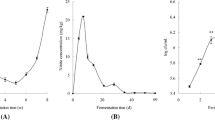Abstract
Pa-som is a traditional salty fermented food made from varieties of freshwater fish with garlic and rice in Laos. A similar product, plaa-som, is made in Thailand. To investigate the fermentation process of pa-som, lactic acid production and pH were monitored during laboratory-scale production of pa-som. Furthermore, the variety of bacteria involved and their succession during fermentation were examined using culture-independent polymerase chain reaction (PCR) denaturing gel gradient electrophoresis targeting the 16S ribosomal RNA (rRNA) gene. d- and l-lactic acid production and a decrease in pH were observed in the samples after 1 day of fermentation. The lactic acid content and pH continued to increase and decrease, respectively, until 4 days of fermentation. Overall, six lactic acid bacteria and eight other indigenous bacteria species were detected during pa-som fermentation. Among the lactic acid bacteria detected, two Lactococcus and one Weissella species were detected in samples after 1–4 days of fermentation, suggesting that these three species play major roles in pa-som fermentation from the initial phase. This is the first report to investigate the fermentation process in pa-som at the microbial level. This research approach should be applicable to a wide variety of pa-som and related fermented fishery products in Laos to help understand their microbial diversity and to identify beneficial bacterial species for improving quality.


Similar content being viewed by others
References
Steinkraus KH (2004) Industrialization of Indigenous Fermented Foods, 2nd edn. Marcel Dekker, New York
Wongba N, Thaewnongiew K, Phathee K, Laithavewat L, Duangsong R, Promthet S, Tangsawad S (2011) Liver fluke prevention and control in the northeast of Thailand through action research. Asian Pac J Cancer Prev 12:1367–1370
Miyashita M, Yukphan P, Chaipitakchonlatarn W, Malimas T, Sugimoto M, Yoshino M, Potacharoen W, Tanasupawat S, Nakagawa Y, Kirtikara K et al (2012) 16S rRNA gene sequence analysis of lactic acid bacteria isolated from fermented foods in Thailand. Microbiol Cult Coll 28:1–9
Tanasupawat S, Komagata K (1995) Lactic acid bacteria in fermented foods in Thailand. World J Microbiol Biotechnol 11:253–256
Tanasupawat S (2009) Thai lactic acid bacteria: diversity and applications. SWU Sci J 25:1–13
Cocolin L, Alessandria V, Dolci P, Gorra R, Rantsiou K (2013) Culture independent methods to assess the diversity and dynamics of microbiota during food fermentation. Int J Food Microbiol 167:29–43
Kim TW, Lee JH, Kim SE, Park MH, Chang HC, Kim HY (2009) Analysis of microbial communities in doenjang, a Korean fermented soybean paste, using nested PCR-denaturing gradient gel electrophoresis. Int J Food Microbiol 131:265–271
Escobar JC, Bhavnani D, Trueba G, Ponce K, Cevallos W, Eisenberg J (2012) Plesiomonas shigelloides infection, Ecuador, 2004–2008. Emerg Infect Dis 18:322–324
Ankri S, Mirelman D (1999) Antimicrobial properties of allicin from garlic. Microbes Infect 1:125–129
Fujisawa H, Watanabe K, Suma K, Origuchi K, Matsufuji H, Seki T, Ariga T (2009) Antibacterial potential of garlic-derived allicin and its cancellation by sulfhydryl compounds. Biosci Biotechnol Biochem 73:1948–1955
Fujii T, Watanabe S, Horikoshi M, Takahashi H, Kimura B (2011) PCR-DGGE analysis of bacterial communities in funazushi, fermented crucian carp with rice, during fermentation. Fish Sci 77:151–157
Lahtinen S, Ouwehand AC, Salminen S, Von Wright A (2012) Lactic acid bacteria, microbiological and functional aspects, 4th edn. CRC Press, Boca Raton
Steinkraus KH (1983) Lactic acid fermentation in the production of foods from vegetables, cereals and legumes. Antonie Van Leeuwenhoek 49:337–348
Leroy F, De Vuyst L (2004) Lactic acid bacteria as functional starter cultures for the food fermentation industry. Trends Food Sci Technol 15:67–78
Saithong P, Panthavee W, Boonyaratanakornkit M, Sikkhamondhol C (2010) Use of a starter culture of lactic acid bacteria in plaa-som, a Thai fermented fish. J Biosci Bioeng 110:553–557
Acknowledgments
The authors would like to thank Dr. Shinsuke Morioka of JIRCAS for identification of fish species in this study, Mr. Bounsong Vongvichith and Ms. Vonhnida Bounlaphan of the Living Aquatic Resources Research Center (LARReC) for information on pa-som production, and Mrs. Patthinan Varichanan of IFRPD for technical assistance.
Author information
Authors and Affiliations
Corresponding author
Rights and permissions
About this article
Cite this article
Marui, J., Boulom, S., Panthavee, W. et al. Culture-independent analysis of the bacterial community during fermentation of pa-som, a traditional fermented fish product in Laos. Fish Sci 80, 1109–1115 (2014). https://doi.org/10.1007/s12562-014-0780-4
Received:
Accepted:
Published:
Issue Date:
DOI: https://doi.org/10.1007/s12562-014-0780-4




